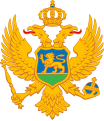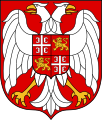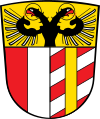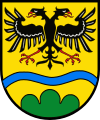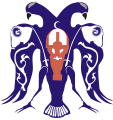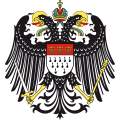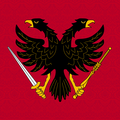Double-headed eagle
One speaks of a double-headed eagle with an eagle that has at least two separate heads, but usually even two separate necks. No double-headed eagle are two half eagles in a split (in the split the whole head is always preserved, see shapes of the eagle ).
Its tincture as emblem can be done as with any eagles in all the heraldic colors and metals.
The crowning of the heads of a double-headed eagle is depicted differently: either each head has its own crown, or a single crown hovers over both heads. A combination of these two representations is also possible (e.g. the great coat of arms of the Russian Empire ). By placing a halo or halo per head, the double-headed eagle is enhanced in its importance.
Long-necked German double-headed eagle of the Middle Ages, simply crowned: Ruhland
Hanseatic city of Tiel with the Austrian imperial crown
The coat of arms of the Powiat Brzeziński shows two half eagles and no double eagle
interpretation
The eagle as the "king of the skies" was and is in most cultures a symbol of high-ranking gods (for Europe especially Zeus and Jupiter ). Analogously, the two-headed status shows a dual principle of rule, in particular “emperor and king”, since the German-Roman emperor only became emperor after a second, sacred coronation. This underlines the prominent position compared to the simple eagle. The interpretation of the double-headed eagle as a symbol of another - of whatever kind - dual principle such as east-west, unity of power or halves of the empire cannot be justified in medieval heraldic terms (it is rather to be seen in the sense of a rank similar to the multiple wings of the seraphim and cherubim , according to Weyss, for example, as a "particularly prudent, four-eyed guardian"), but a much later - according to Diem, however, all the more powerful and influential - reinterpretation.
history
Early double-headed eagle

The first known double-headed eagle dates from the 23rd century BC. From ancient Babylonia . The double-headed eagle of Lagaš as supposedly "the oldest coat of arms in the world" is the symbol of the Scottish Rite of Freemasonry . In the ancient oriental carpet weaving the figures were often reversed. From this carpet style, these opposing pairs of animals were adopted as decorative symmetrical patterns in other branches of art. The double-headed animals emerged from them by shortening them. So the double-headed eagle was created purely technically from two one-headed eagles - even if the European heraldic tradition and more recent symbol research reject this.
According to Weyss, the double-headed eagle developed independently in a number of cultures, for example in Tibet, Pakistan, as the double-headed Garuda on Ceylon, or in Peru.
The double-headed eagle has been a dynastic symbol in Asia Minor since the 4th century, and as a religious symbol in former Armenia (today's border area between Syria and Turkey) as early as 302. With the rulers of Byzantium it spreads through the Aegean and South East Europe and is a symbol in the confrontation with Islam .
The double-headed eagle came to Europe in the 11th century through oriental fabrics and was taken up by art around 1100. Only its use in Romanesque sculpture in France should be mentioned here.
The first double-headed eagle seal appears in 1180 as a freely chosen personality symbol of the Counts of Saar Werden .
The double-headed eagle as an imperial eagle

In the late Byzantine Empire , the double-headed eagle was used by emperors from the family of palaeologists - all European imperial eagles are probably derived from these eagles : The Byzantine double-headed eagle was the triple-crowned double-headed eagle, later with a breastplate showing St. George. Detectable after 1453 and especially on Russian coats of arms.
From Byzantium the Russian Tsarist Empire took over the double-headed eagle in gold on a red background as " the third Rome " - after the " pagan " Rome and the Christian Constantinople - since 1487. This derivation is, however, quite controversial.
The Holy Roman Empire used the double-headed eagle in black on gold since the reign of Emperor Sigismund , the exact decision dates back to 1433. Before that, the one-headed eagle was considered a symbol of imperial power. The one-headed eagle was already diminished (with a halo), the double-headed one remains.
The German Empire , established in 1871, replaced the double-headed eagle with a single-headed eagle.
In 1804, Emperor Franz I founded the Austrian Empire , for which he borrowed the double eagle / quaternion eagle of the Holy Roman Empire as the coat of arms and designated it in a modified form as the Austrian coat of arms . Only two years later he laid down the imperial dignity of the Holy Roman Empire and declared the empire extinct. Austria carried the double-headed eagle until the dissolution of the Austro-Hungarian monarchy in 1918. Austria has carefully followed political changes for a long time: The breastplate of its double-headed eagle swelled to sixty-two fields in the “large” coat of arms, and in the “middle” it was based on the quaternion eagle - the wing-feathers shields of the hereditary lands , including Hungary . At the time of Austrofascism between 1934 and 1938 the coat of arms eagle was again double-headed and nimbated again.
The Greek Orthodox Church also carries the double-headed eagle in takeover from Ostrom. The Armenian Church uses the symbol of the double-headed eagle after 1300 years of tradition.
After their conquest of Anatolia , the Rum Seljuks from the Byzantine Empire adopted the motif of the double-headed eagle on madrasas and mosques in the 12th and 13th centuries . One example is the Divriği Mosque in the small town of the same name . On the top of a tree of life , the double-headed eagle appears on a stone relief on the entrance facade of the madrasa in Erzurum (Çifte Minare Medresesi) .
Austria's coat of arms 1934–1938 with nimbly eagle
Coat of arms of Rethondes (see clearing of Compiègne )
Double-headed eagle on the facade of the Divriği Mosque (Turkey)
The double-headed eagle as the city's coat of arms


The golden double-headed eagle on black, adorned with the imperial crown, was given to the city of Vienna by Emperor Friedrich III on September 26, 1461 . as thanks for the fact that the Viennese gave him against the attack of his brother Albrecht VI. had helped, and thus replaced the previously used golden, single-headed eagle in the black field.
Soon afterwards, the loyalty of the city of Vienna turned into disobedience: instead of standing by the emperor, the citizens besieged him, his wife and his four-year-old son in the Vienna castle. With all kinds of weapons, around one hundred men from Krems set out in 1462 to help the emperor. Therefore, Emperor Friedrich III. returned the coat of arms of Vienna and transferred it on April 1, 1463 to the two loyal sister cities of Krems and Stein. Since then, Krems has been selling the golden double-headed eagle in black with the imperial crown (with a high miter) and two fluttering ribbons, but without halos.
Uses
National coat of arms
- Since the dissolution of the USSR, the double-headed eagle has again been included in the national coat of arms of Russia .
- Albania is one of the few nations that still has the double-headed eagle in their national flag . This double-headed eagle can be traced back to the Albanian national hero Skanderbeg (1405–1468), who used it as a seal. It was declared the national coat of arms when Albania became independent in 1912.
- There was a double-headed eagle in the national coat of arms of Serbia and Montenegro , as well as in the coats of arms of the two individual states, which have been separate since 2006.
- Based on the Russian coat of arms, the unrecognized People's Republics of Donetsk and Lugansk use the double-headed eagle in their flags.
Others
The double-headed eagle appears in the coats of arms of noble houses, rural districts, cities, guilds ( shoemakers ) and many other associations.
- Counties
Coat of arms of the Bavarian administrative district of Swabia
District coat of arms of the Alb-Donau district
Coat of arms of the Deggendorf district
Coat of arms of the Ortenau district
- City arms
City arms of Arnhem
Flag of Athos
Coat of arms of the city of Duisburg
Erzincan city arms
City arms of Groningen
Coat of arms of the Turkish city Konya
Coat of arms of Lübeck
City coat of arms Neuss
City arms of Nijmegen
Pommelsbrunn with Brandenburg and Nuremberg eagles
City flag with Rijeka city coat of arms
Ruhland coat of arms
Toledo city arms
Velletri city arms
Wiener Neustadt coat of arms
particularities
- A special feature is the double-headed rooster instead of the double-headed eagle in the coat of arms of Versailles . Here the French national animal has assumed the role of an eagle.
literature
- Friedrich-Karl zu Hohenlohe-Waldenburg: On the history of the heraldic double eagle . Weise, Stuttgart 1871 ( digitized version )
- Ernst Kornemann: eagle and double-headed eagle in the coat of arms of the German Empire. On the prehistory of the double-headed eagle. In: Heinrich Dannenbauer, Fritz Ernst (ed.): The Empire - Idea and Shape. Festschrift for Johannes Haller on his 75th birthday . Stuttgart 1940, pp. 45–68, reprinted in: Ernst Kornemann: Gestalten und Reiche. Ancient History Essays . Bremen 1980, pp. 402-415.
- Norbert Weyss: The double-headed eagle - history of a symbol. In: Adler Heft 3, 1986, 78 ff.
- Norbert Weyss: The double-headed eagle around the world, history of a symbol. Exhibition catalog, series of publications by the Mödling District Museum Association, No. 83, February 1994
Web links
- Peter Diem: The development of the Austrian double-headed eagle
- Entry on the double-headed eagle in the Austria Forum (in the AEIOU Austria Lexicon )
Individual evidence
- ↑ a b c d e Peter Diem: The symbols of Austria. Time and history in signs. K&S Vienna 1995, ISBN 3-218-00594-9 (Web excerpt Diem, development of the double-headed eagle, see web links)
- ↑ a b lit .: Weyss, Der Doppeladler. Quoted from Diem, Doppeladler , section The meaning for Austria
- ^ Double-Headed Eagle of Lagash
- ↑ Norbert Weyss: The development of double-headed eagle research. Austrian Science Forum, 1988 / 1–2 and 1989 / 1–2
- ↑ Diem, Doppeladler , section The Byzantine Relatives
- ↑ see Imperial Eagle # Eagle of the Russian Empire
- ^ Franz Gall: On the development of the double eagle on the imperial seals. In: Adler , Volume 8, Issue 16/17, 1970, pp. 281 ff.
- ↑ Michael Göbl: State symbols of the Habsburg Empire - from 1867 with special consideration of the state coat of arms. In: Austria's political symbols. Böhlau, Vienna, 1994, 11ff
- ↑ see for example the Armenian Apostolic Church of Switzerland , ref. according to Diem
- ^ Peter Diem: The symbols of Vienna (overall representation) , Austria Forum
- ^ Karl Lind: The coat of arms of the city of Vienna. Vienna 1866, p. 24 ff.
- ^ Franz Schönfellner : Krems: City arms for 550 years , ORF, Lower Austria today, May 22, 2013
- ^ Hugo Gerard Ströhl : city arms of Austria-Hungary. Vienna 1904














